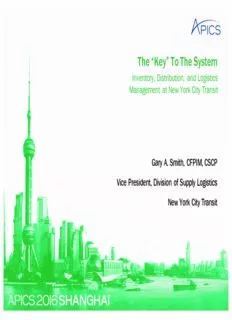
PPT - APICS Shanghai The Key To The System Final PDF
Preview PPT - APICS Shanghai The Key To The System Final
The “Key” To The System Inventory, Distribution, and Logistics Management at New York City Transit Gary A. Smith, CFPIM, CSCP Vice President, Division of Supply Logistics New York City Transit Gary A. Smith, CFPIM, CSCP § Over 35 years as a Supply Chain Professional − Last 12 years in public sector § Vice President, Supply Logistics, New York City Transit § APICS Member since 1998 § Director New York City Programs APICS NYC-LI Chapter § Author, Executive View column, APICS Magazine § CLTD Certification Committee Member Session Objectives § The importance of distribution and logistics to NYCT’s (and your organization’s) success § Identify strategies for efficient distribution flow to meet the needs of the organization § Identify appropriate inventory, distribution, and logistics best practices for your organization § Practical applications of inventory, distribution, and logistics concepts in the real world § How Supply Logistics’ culture contributes to its success NYCT Overview § Largest agency of the Metropolitan Transportation Authority − New York City Transit − Long Island Railroad − Metro North Railroad − Bridges and Tunnels − Capital Construction § 6,300 Subway Cars § 5,700 Buses § Daily Ridership – 8 Million § 47,500 Employees § 24 Hours per Day / 7 Days per Week / 52 Weeks per Year “We Never Close!” Division of Supply Logistics § 558 Staff (1.2%) § Operating Budget - $64 million (1.3%) § Active SKU’s = 91,000 § Approximately 1.5 million Sq. Ft. of Warehouse Space − 65 Storerooms − 4 Warehouses § 2015 Material Issues − 2.4 Million Lines (- 4.7% over 2014) − $340.5 Million (+4.3% over 2014) § Inventory Accuracy – 99.5% § Fill Rate – 95.5% Distribution Challenges for Supply Logistics § SKU Proliferation – 91,000+ active SKUs § Diversified Fleets − 12 Subway Car Models – 1.7 Models/Barn − 42 Make/Models Bus – 5.0 Models/Depot § Average Age of Fleets − Subways – 19.4 Years 40 year Lifespan − Buses – 9.5 Years 12 year Lifespan (1,000 new buses in next 3 years) § Numerous Inventory Locations (69) § Limited Capital Budget § Operating Budget Reductions Distribution Challenges for Supply Logistics § Limited Warehouse Space − Maspeth & Tiffany Warehouse Space -809,975 − Non-Standard Inventory - 20% • Capital Projects • Capital Spares • Recovery and Resiliency • Pandemic Supplies • Automated Fare Collection • Kitting − Available for Standard Inventory 647,980 § Limited Storeroom Space − Average Subway Storeroom = 3,229 sq.ft. − Average Bus Storeroom = 5,542 sq.ft. Importance of Distribution and Logistics to NYCT – The “Key” to the System § NYC economy is dependent on efficiently moving people around the city. Therefore, NYCT’s subways and buses must be kept in good repair in order to maintain safe and reliable service. § Daily ridership has increased steadily over the last 5 years. This has required increased demand for parts to repair equipment and maintain and upgrade infrastructure. § Repair parts and other supplies have to be distributed efficiently to the various bus depots, subway barns, and other locations that operate 24/7 in order to meet service needs. § Material must be secure, easily accessible, and inventory must be accurate. 3 Global Trends Impacting Distribution § Industry Consolidations − Shippers / Suppliers − Carriers − Customers § Continuous Flow Manufacturing and Demand-Pull Distribution − Flow-through (crossdock) centers − Direct store delivery − Smaller, more frequent deliveries § Focus on the Customer − Quality has shifted from an order winner to an order qualifier − Customers are no longer equal − Omni-channel Marketing § Distribution must be flexible, cost effective, and accurate! The Five Drivers of Cost § Time − Parkinson’s Law – “Work expands to fill the time allotted for it.” § Transactions (volume) § Errors (mistakes) § Specialization § (Over / Micro) Management − “Anything you are doing that does not benefit the customer is a waste of time.” Source: Ken Miller, Extreme Government Makeover Used with Permission
Description: